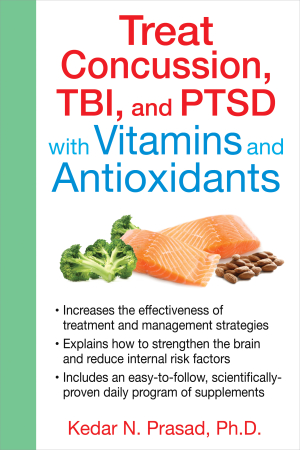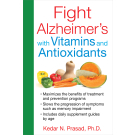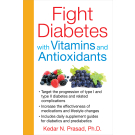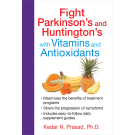Treat Concussion, TBI, and PTSD with Vitamins and Antioxidants
By (Author) Kedar N. Prasad, Ph.D.
Availability:
In Stock
- Pages: 224
- Book Size: 6 x 9
- ISBN-13: 9781620554357
- Imprint: Healing Arts Press
- On Sale Date: January 2, 2016
- Format: Paperback Book
Kedar N. Prasad, Ph.D., reveals the latest discoveries on the use of antioxidants and micronutrients to manage and prevent concussive injury, TBI, and PTSD. Includes an easy-to-follow supplement program, outlining the correct daily amounts and proper combinations of vitamins, antioxidants, micronutrients, and polyphenolic compounds.
The most up-to-date resource on nutritional supplements for the prevention and improved management of concussive injury, TBI, and PTSD
• Provides an easy-to-follow program of supplements to optimize the benefits of treatment programs and offer a method of prevention beyond the use of helmets
• Shows how standard treatments do not address the oxidative stress, chronic inflammation, and high glutamate levels that promote brain injury progression
• Explains how single micronutrients do not provide the same preventive benefits as the synergistic combinations explored in the book
The human brain is highly complex. When brain injury strikes, whether from a blow to the head or the shock of physical or emotional trauma, successful treatment requires a multilevel approach, taking into account the health of the brain prior to injury. Multilevel, complementary treatment approaches can also be applied to strengthen the uninjured brain and help prevent neurological injury for those at high risk of concussion, post-traumatic stress disorder, and traumatic brain injury.
In this practical scientific guide, leading researcher in cancer, heart disease, and Alzheimer’s prevention Kedar N. Prasad, Ph.D., reveals the latest revolutionary discoveries on the use of antioxidants and micronutrients to manage and prevent concussive injury, TBI, and PTSD. He explains that increased oxidative stress, chronic inflammation, and glutamate release are common underlying factors in these conditions and should be addressed for improved management. He debunks the flawed conclusions of the neurological community that vitamins and antioxidants are ineffective for these conditions, revealing how their studies focused on specific micronutrients rather than synergistic combinations. The author details his easy-to-follow supplement program to treat and prevent these injuries, outlining the correct daily amounts and proper combinations of vitamins, antioxidants, micronutrients, and polyphenolic compounds such as curcumin and resveratrol.
Offering the missing complement to standard medical care of brain injury as well as a form of prevention beyond the use of helmets, this guide provides a truly holistic approach to the prevention and management of concussive injury, TBI, and PTSD.
• Provides an easy-to-follow program of supplements to optimize the benefits of treatment programs and offer a method of prevention beyond the use of helmets
• Shows how standard treatments do not address the oxidative stress, chronic inflammation, and high glutamate levels that promote brain injury progression
• Explains how single micronutrients do not provide the same preventive benefits as the synergistic combinations explored in the book
The human brain is highly complex. When brain injury strikes, whether from a blow to the head or the shock of physical or emotional trauma, successful treatment requires a multilevel approach, taking into account the health of the brain prior to injury. Multilevel, complementary treatment approaches can also be applied to strengthen the uninjured brain and help prevent neurological injury for those at high risk of concussion, post-traumatic stress disorder, and traumatic brain injury.
In this practical scientific guide, leading researcher in cancer, heart disease, and Alzheimer’s prevention Kedar N. Prasad, Ph.D., reveals the latest revolutionary discoveries on the use of antioxidants and micronutrients to manage and prevent concussive injury, TBI, and PTSD. He explains that increased oxidative stress, chronic inflammation, and glutamate release are common underlying factors in these conditions and should be addressed for improved management. He debunks the flawed conclusions of the neurological community that vitamins and antioxidants are ineffective for these conditions, revealing how their studies focused on specific micronutrients rather than synergistic combinations. The author details his easy-to-follow supplement program to treat and prevent these injuries, outlining the correct daily amounts and proper combinations of vitamins, antioxidants, micronutrients, and polyphenolic compounds such as curcumin and resveratrol.
Offering the missing complement to standard medical care of brain injury as well as a form of prevention beyond the use of helmets, this guide provides a truly holistic approach to the prevention and management of concussive injury, TBI, and PTSD.
5
Managing Concussive Injury
Vitamins and Antioxidants for Prevention and Treatment
Types of Concussive Brain Injuries
Neurological diseases such as post-traumatic stress disorder (PTSD), traumatic brain injury (TBI), and concussion are induced by external agents, such as contact sports, blast, and accidents involving the brain.
PTSD is a complex brain disease often caused by an exposure to blast in a military conflict; sudden or repeated extreme traumatic events such as war, terrorism, natural- or human-caused disaster; as well as violent personal assault such as rape, mugging, domestic violence, and accidents. There is also a strong direct relationship between mild traumatic brain injury and PTSD.
Traumatic brain injury (TBI), also called head injury, occurs when a sudden trauma causes damage to the brain. The damage to the brain after severe TBI occurs in three phases. The first phase involves primary injury to the brain tissue that cannot be reversed. The second phase of severe TBI occurs soon after injury and continues for days to weeks and contributes to the development of secondary damage that eventually leads to neurological disorders and neuronal death. During this period of injury, intervention with appropriate agents can slow the progression of damage. The third phase of severe TBI appears as late effects that depend upon the initial areas of the brain that were damaged. The late effects may include cognitive dysfunction, PTSD, and other behavior abnormalities.
Related to TBI is a concussive brain injury, which can also be called mild traumatic brain injury (mTBI). This injury can express as a mild, moderate, or severe form. Concussive injury occurs when the brain is violently rocked back and forth within the skull following a blow to the head or neck such as those observed in contact sports like football and soccer. Concussive injury also occurs during the rapid displacement and rotation of the cranium after peak head acceleration. In combat zones, concussive injury occurs among troops exposed to a blast pressure wave, such as following detonation of an explosive device. This injury is characterized by the immediate and transient changes in brain function that include temporary loss of memory, confusion, poor balance and reflexes, and hearing loss.
Although concussive injury has occurred in players of contact sports and in troops returning from wars, only recently has it drawn intense public and scientific debates. This is due to the fact that increased rates of serious mental disorders, including cognitive dysfunction and abnormal behavior (fear, anxiety, anger, and suicidal tendency), are being observed among retired professional football players and war veterans.
Current strategies for reducing the adverse impacts of concussion on brain function have focused on the development of physical protection to guard the skull from the impact of concussion. Introduction of newer football helmets appears to lower the risk of concussion by about 10 to 20 percent, which still is very small. Despite availability of stateof- the art protective equipment, concussive brain injury remains a major health risk for professional football players and for veterans. They continue to suffer from the late adverse consequences of concussion. The physical protective gear currently available is not sufficient to reduce these acute- and long-term adverse consequences.
A Strategy for Managing
Late Adverse Effect s of Concussion
Except for physical protection of the skull, there are no satisfactory therapeutic strategies to protect the brain from concussion. Once injured, it is essential to know major biochemical defects that initiate this degeneration to protect the concussed brain from further damage. As described earlier in the book, increased oxidative stress and chronic inflammation are major biochemical defects that initiate damage in the brain following concussion. Therefore, reducing these biochemical defects would help protect the brain from concussive injury and would complement the protection provided by helmets and other protective gear.
The current standard therapy for managing the late adverse effects of concussion does not address the levels of oxidative stress, chronic inflammation, and glutamate release and its toxicity that altogether contribute to the progression of concussive injury. Reducing these biochemical defects in combination with standard therapy would greatly reduce the progression of concussive injury and improve the management of this injury more than is accomplished by standard therapy alone.
Recommended Micronutrients in Primary Prevention of Concussion
The selected combination of nontoxic agents include vitamin A, vitamin E, natural mixed carotenoids, vitamin C, vitamin D, B vitamins with higher levels of vitamin B3, selenium, coenzyme Q10, alpha-lipoic acid, N-acetylcysteine, L-carnitine, omega-3-fatty acids, resveratrol, and curcumin. Together these agents provide an optimal reduction of oxidative stress and chronic inflammation by activating the Nrf2/ARE pathway without ROS stimulation and by directly scavenging free radicals.
Managing Concussive Injury
Vitamins and Antioxidants for Prevention and Treatment
Types of Concussive Brain Injuries
Neurological diseases such as post-traumatic stress disorder (PTSD), traumatic brain injury (TBI), and concussion are induced by external agents, such as contact sports, blast, and accidents involving the brain.
PTSD is a complex brain disease often caused by an exposure to blast in a military conflict; sudden or repeated extreme traumatic events such as war, terrorism, natural- or human-caused disaster; as well as violent personal assault such as rape, mugging, domestic violence, and accidents. There is also a strong direct relationship between mild traumatic brain injury and PTSD.
Traumatic brain injury (TBI), also called head injury, occurs when a sudden trauma causes damage to the brain. The damage to the brain after severe TBI occurs in three phases. The first phase involves primary injury to the brain tissue that cannot be reversed. The second phase of severe TBI occurs soon after injury and continues for days to weeks and contributes to the development of secondary damage that eventually leads to neurological disorders and neuronal death. During this period of injury, intervention with appropriate agents can slow the progression of damage. The third phase of severe TBI appears as late effects that depend upon the initial areas of the brain that were damaged. The late effects may include cognitive dysfunction, PTSD, and other behavior abnormalities.
Related to TBI is a concussive brain injury, which can also be called mild traumatic brain injury (mTBI). This injury can express as a mild, moderate, or severe form. Concussive injury occurs when the brain is violently rocked back and forth within the skull following a blow to the head or neck such as those observed in contact sports like football and soccer. Concussive injury also occurs during the rapid displacement and rotation of the cranium after peak head acceleration. In combat zones, concussive injury occurs among troops exposed to a blast pressure wave, such as following detonation of an explosive device. This injury is characterized by the immediate and transient changes in brain function that include temporary loss of memory, confusion, poor balance and reflexes, and hearing loss.
Although concussive injury has occurred in players of contact sports and in troops returning from wars, only recently has it drawn intense public and scientific debates. This is due to the fact that increased rates of serious mental disorders, including cognitive dysfunction and abnormal behavior (fear, anxiety, anger, and suicidal tendency), are being observed among retired professional football players and war veterans.
Current strategies for reducing the adverse impacts of concussion on brain function have focused on the development of physical protection to guard the skull from the impact of concussion. Introduction of newer football helmets appears to lower the risk of concussion by about 10 to 20 percent, which still is very small. Despite availability of stateof- the art protective equipment, concussive brain injury remains a major health risk for professional football players and for veterans. They continue to suffer from the late adverse consequences of concussion. The physical protective gear currently available is not sufficient to reduce these acute- and long-term adverse consequences.
A Strategy for Managing
Late Adverse Effect s of Concussion
Except for physical protection of the skull, there are no satisfactory therapeutic strategies to protect the brain from concussion. Once injured, it is essential to know major biochemical defects that initiate this degeneration to protect the concussed brain from further damage. As described earlier in the book, increased oxidative stress and chronic inflammation are major biochemical defects that initiate damage in the brain following concussion. Therefore, reducing these biochemical defects would help protect the brain from concussive injury and would complement the protection provided by helmets and other protective gear.
The current standard therapy for managing the late adverse effects of concussion does not address the levels of oxidative stress, chronic inflammation, and glutamate release and its toxicity that altogether contribute to the progression of concussive injury. Reducing these biochemical defects in combination with standard therapy would greatly reduce the progression of concussive injury and improve the management of this injury more than is accomplished by standard therapy alone.
Recommended Micronutrients in Primary Prevention of Concussion
The selected combination of nontoxic agents include vitamin A, vitamin E, natural mixed carotenoids, vitamin C, vitamin D, B vitamins with higher levels of vitamin B3, selenium, coenzyme Q10, alpha-lipoic acid, N-acetylcysteine, L-carnitine, omega-3-fatty acids, resveratrol, and curcumin. Together these agents provide an optimal reduction of oxidative stress and chronic inflammation by activating the Nrf2/ARE pathway without ROS stimulation and by directly scavenging free radicals.
Foreword by Stephen Bondy, Ph.D.
Preface Why Should You Read This Book?
1 Structure and Function of the Human Brain
2 Oxidative Stress, Inflammation, and the Immune System
3 The Antioxidant Defense System
4 The Role of Antioxidants in Reducing Oxidative Damage
5 Concussive Injury: Causes, Symptoms, Incidence, and Costs
6 Treating and Managing Concussive Injury with Vitamins and Antioxidants
7 Penetrating Traumatic Brain Injury: Symptoms and Long-Term Effects, Incidence, and Costs
8 Treating and Managing Penetrating TBI with Vitamins and Antioxidants
9 Post-Traumatic Stress Disorder (PTSD): Causes, Symptoms, Prevalence, and Costs
10 Treating and Managing PTSD with Vitamins and Antioxidants
Appendix Values of Recommended Dietary Allowances (RDA)/Dietary Reference Intakes (DRI)
Abbreviations and Terminologies
Bibliography
Index
About the Author
Preface Why Should You Read This Book?
1 Structure and Function of the Human Brain
2 Oxidative Stress, Inflammation, and the Immune System
3 The Antioxidant Defense System
4 The Role of Antioxidants in Reducing Oxidative Damage
5 Concussive Injury: Causes, Symptoms, Incidence, and Costs
6 Treating and Managing Concussive Injury with Vitamins and Antioxidants
7 Penetrating Traumatic Brain Injury: Symptoms and Long-Term Effects, Incidence, and Costs
8 Treating and Managing Penetrating TBI with Vitamins and Antioxidants
9 Post-Traumatic Stress Disorder (PTSD): Causes, Symptoms, Prevalence, and Costs
10 Treating and Managing PTSD with Vitamins and Antioxidants
Appendix Values of Recommended Dietary Allowances (RDA)/Dietary Reference Intakes (DRI)
Abbreviations and Terminologies
Bibliography
Index
About the Author
Kedar N. Prasad, Ph.D., is the chief scientific officer of the Premier Micronutrient Corporation, the former director of the Center for Vitamins and Cancer Research at the University of Colorado School of Medicine, and the former president of the International Society of Nutrition and Cancer. The author of several books, including Fight Alzheimer’s with Vitamins and Antioxidants, he lives in the San Francisco Bay Area.
“One of the leading and respected authorities in the field of antioxidant use.”
Jeanne Drisko, M.D., CNS, FACN, Integrative Medicine program director, University of Kansas Medical Center
“Kedar Prasad’s new book Treat Concussion, TBI, and PTSD with Vitamins and Antioxidants is steeped in deep knowledge of science and biochemistry. Vitamins and antioxidants work best for these conditions when they work in synergy with one another.”
William Jiang, MLS, author of Guide to Natural Mental Health: Anxiety, Bipolar, Depression, Schizophrenia, and Digital Addiction
Jeanne Drisko, M.D., CNS, FACN, Integrative Medicine program director, University of Kansas Medical Center
“Kedar Prasad’s new book Treat Concussion, TBI, and PTSD with Vitamins and Antioxidants is steeped in deep knowledge of science and biochemistry. Vitamins and antioxidants work best for these conditions when they work in synergy with one another.”
William Jiang, MLS, author of Guide to Natural Mental Health: Anxiety, Bipolar, Depression, Schizophrenia, and Digital Addiction
HEALTH / NUTRITION
“Kedar Prasad’s new book Treat Concussion, TBI, and PTSD with Vitamins and Antioxidants is steeped in deep knowledge of science and biochemistry. Vitamins and antioxidants work best for these conditions when they work in synergy with one another.”
--William Jiang, MLS, author of Guide to Natural Mental Health: Anxiety, Bipolar, Depression, Schizophrenia, and Digital Addiction
The human brain is highly complex. When brain injury strikes, whether from a blow to the head or the shock of physical or emotional trauma, successful treatment requires a multilevel approach, taking into account the health of the brain prior to injury. Multilevel, complementary treatment approaches can also be applied to strengthen the uninjured brain and help prevent neurological injury for those at high risk of concussion, post-traumatic stress disorder, and traumatic brain injury.
In this practical scientific guide, leading researcher in cancer, heart disease, and Alzheimer’s prevention Kedar N. Prasad, Ph.D., reveals the latest revolutionary discoveries on the use of antioxidants and micronutrients to manage concussive injury, TBI, and PTSD. He explains that increased oxidative stress, chronic inflammation, and glutamate release are common underlying factors in these conditions and should be addressed for improved management. He debunks the flawed conclusions of the neurological community that vitamins and antioxidants are ineffective for these conditions, revealing how their studies focused on specific micronutrients rather than synergistic combinations. The author details his easy-to-follow supplement program to treat and prevent further damage from these injuries, outlining the correct daily amounts and proper combinations of vitamins, antioxidants, micronutrients, and polyphenolic compounds such as curcumin and resveratrol.
Offering the missing complement to standard medical care of brain injury as well as a form of prevention beyond the use of helmets, this guide provides a truly holistic approach to the prevention and management of concussive injury, TBI, and PTSD.
KEDAR N. PRASAD, Ph.D., is currently the chair for the Global Brain Research Institute in Santa Rosa, California. He is the former chief scientific officer of the Premier Micronutrient Corporation, the former director of the Center for Vitamins and Cancer Research at the University of Colorado School of Medicine, and the former president of the International Society of Nutrition and Cancer. The author of several books, including Fight Alzheimer’s with Vitamins and Antioxidants, he lives in the San Francisco Bay Area.
“Kedar Prasad’s new book Treat Concussion, TBI, and PTSD with Vitamins and Antioxidants is steeped in deep knowledge of science and biochemistry. Vitamins and antioxidants work best for these conditions when they work in synergy with one another.”
--William Jiang, MLS, author of Guide to Natural Mental Health: Anxiety, Bipolar, Depression, Schizophrenia, and Digital Addiction
The human brain is highly complex. When brain injury strikes, whether from a blow to the head or the shock of physical or emotional trauma, successful treatment requires a multilevel approach, taking into account the health of the brain prior to injury. Multilevel, complementary treatment approaches can also be applied to strengthen the uninjured brain and help prevent neurological injury for those at high risk of concussion, post-traumatic stress disorder, and traumatic brain injury.
In this practical scientific guide, leading researcher in cancer, heart disease, and Alzheimer’s prevention Kedar N. Prasad, Ph.D., reveals the latest revolutionary discoveries on the use of antioxidants and micronutrients to manage concussive injury, TBI, and PTSD. He explains that increased oxidative stress, chronic inflammation, and glutamate release are common underlying factors in these conditions and should be addressed for improved management. He debunks the flawed conclusions of the neurological community that vitamins and antioxidants are ineffective for these conditions, revealing how their studies focused on specific micronutrients rather than synergistic combinations. The author details his easy-to-follow supplement program to treat and prevent further damage from these injuries, outlining the correct daily amounts and proper combinations of vitamins, antioxidants, micronutrients, and polyphenolic compounds such as curcumin and resveratrol.
Offering the missing complement to standard medical care of brain injury as well as a form of prevention beyond the use of helmets, this guide provides a truly holistic approach to the prevention and management of concussive injury, TBI, and PTSD.
KEDAR N. PRASAD, Ph.D., is currently the chair for the Global Brain Research Institute in Santa Rosa, California. He is the former chief scientific officer of the Premier Micronutrient Corporation, the former director of the Center for Vitamins and Cancer Research at the University of Colorado School of Medicine, and the former president of the International Society of Nutrition and Cancer. The author of several books, including Fight Alzheimer’s with Vitamins and Antioxidants, he lives in the San Francisco Bay Area.











